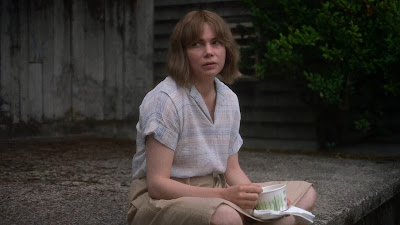It this kind of direct and comic clarity that demonstrates how Reichardt eschews a romanticized notion of a struggling artist, just as she inverts the stereotype of a tortured artist through Lizzy’s mentally ill brother Sean (John Magaro), who might have once had artistic promise himself, that their mother can’t help but cling to, even as he claims the hole he’s digging in his backyard is some sort of earthwork as artwork. It’s not an insensitive moment, just a harshly revealing one, that we don’t create because of what ails us but despite it.
If Sean is a contrast to Lizzy, so is Jo. She’s also an artist, albeit more successful, with two upcoming shows to Lizzy’s one. This character could have been annoying comic relief or simple antagonist, but not only does Chau provide her with a mellow human dimension, Jo is not conceived in such simpleminded terms. True, her introduction, putting up a tire swing as Lizzy wonders when the hot water will be fixed, evinces an obvious dichotomy, but Jo’s sunnier attitude is ultimately portrayed as a direct result of her more assured footing in the artistic landscape, how one can afford to me more blissfully unaware when struggles to finish your sculpture because you’re struggling to make rent are not intertwined.
Jo is not the only one with a sunny attitude. There is also Eric, kiln master at the art school, just a peripheral character, really, even though he is played by André 3000, and when he fires one of her ceramics, it comes up slightly burnt. He says it looks kinda cool, which in his André 3000 voice you kinda believe, though Lizzy clearly doesn’t believe it looks cool and never comes around to believing it either. Just as the character who mentions how impressed she is with Lizzy works never signals some upward swing for Lizzy, this moment with the kiln never suggests something kismet, just a ruining of her hard work, which is how “Showing Up” ultimately sees art – as hard work.
Reichardt presents the art school as a hub of energy, of people creating and coming and going, even as her framing of Lizzy and the performance of Williams deliberately render her as an afterthought, not unlike the dog sitting in the doorway that people are always stepping around or over. It is in her eyes, though, where you detect Lizzy’s imagination always at work, like in the scene where she sits outside eating lunch and watching people in the grass partake in a class called Thinking in Movement. It’s humorous, their motion compared to her severe stasis, but the way Williams has Lizzy watch belies someone taking in everything she is seeing. Indeed, in sculpting her statues, positioning the bodies and arms, she seems to be thinking in movement, and the way Reichardt positions the camera over Lizzy’s shoulder in these moments of Lizzy at work create nothing less than a visual symbiosis of the artist as her work.





No comments:
Post a Comment